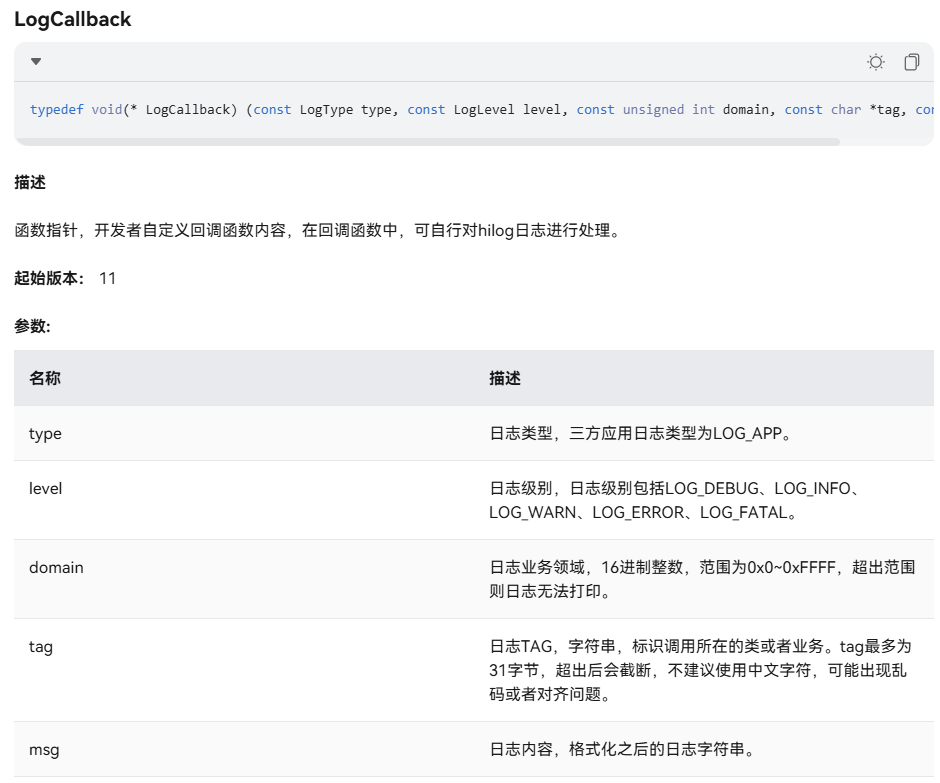有没有获取线程号的C API?日志怎么打印线程号? HarmonyOS 鸿蒙Next
有没有获取线程号的C API?日志怎么打印线程号? HarmonyOS 鸿蒙Next 使用 OH_LOG_SetCallback 设置日志回调,实现保存日志到文件的功能,
这个进程中有多个线程,怎么在日志中增加线程号?回调的内容中没有线程号

更多关于有没有获取线程号的C API?日志怎么打印线程号? HarmonyOS 鸿蒙Next的实战教程也可以访问 https://www.itying.com/category-93-b0.html
2 回复
以下内容仅供参考
在鸿蒙系统中通过C++实现带线程号的日志回调,需要注意线程安全和线程ID获取。以下是实现方案:
#include <mutex>
#include <fstream>
#include <thread>
#include <chrono>
#include <iomanip>
#include "hilog/log.h"
std::mutex g_logMutex;
std::ofstream g_logFile("app.log", std::ios::app);
void LogCallback(OH_LogLevel level, const char* tag, const char* fmt, ...) {
std::lock_guard<std::mutex> lock(g_logMutex);
// 获取线程ID
std::stringstream threadIdStream;
threadIdStream << std::this_thread::get_id();
std::string threadId = threadIdStream.str();
// 获取时间戳
auto now = std::chrono::system_clock::now();
auto ms = std::chrono::duration_cast<std::chrono::milliseconds>(
now.time_since_epoch()) % 1000;
auto timer = std::chrono::system_clock::to_time_t(now);
std::tm bt = *std::localtime(&timer);
// 格式化日志
char timestamp[24];
snprintf(timestamp, sizeof(timestamp),
"%04d-%02d-%02d %02d:%02d:%02d.%03ld",
bt.tm_year + 1900, bt.tm_mon + 1, bt.tm_mday,
bt.tm_hour, bt.tm_min, bt.tm_sec, ms.count());
// 解析可变参数
va_list args;
va_start(args, fmt);
char logContent[1024];
vsnprintf(logContent, sizeof(logContent), fmt, args);
va_end(args);
// 组合完整日志行
std::string levelStr;
switch(level) {
case LOG_DEBUG: levelStr = "D"; break;
case LOG_INFO: levelStr = "I"; break;
case LOG_WARN: levelStr = "W"; break;
case LOG_ERROR: levelStr = "E"; break;
default: levelStr = "U";
}
std::stringstream logLine;
logLine << timestamp
<< " [" << threadId << "] "
<< levelStr << "/" << tag << ": "
<< logContent << std::endl;
// 写入文件
if (g_logFile.is_open()) {
g_logFile << logLine.str();
g_logFile.flush();
}
}
// 初始化函数
void InitLogSystem() {
OH_LOG_SetLogLevel(LOG_LEVEL_DEBUG);
OH_LOG_SetCallback(LogCallback);
}
关键实现要点:
-
线程安全机制:
- 使用
std::mutex保证文件写入的原子性 - 通过
std::lock_guard实现RAII风格的锁管理 - 每次回调都进行完整的日志组装和写入操作
- 使用
-
线程ID获取:
std::stringstream threadIdStream; threadIdStream << std::this_thread::get_id();使用C++标准库获取当前线程ID,输出示例:
140245072824064 -
高性能时间戳:
- 使用
<chrono>获取毫秒级精度时间 - 通过
std::localtime转换本地时间 - 格式示例:
2024-03-20 14:35:22.358
- 使用
-
日志格式优化:
2024-03-20 14:35:22.358 [140245072824064] D/MyTag: debug message包含:
- 时间戳(精确到毫秒)
- 线程ID(方括号包裹)
- 日志级别(单字母表示)
- 日志标签
- 原始日志内容
-
文件操作优化:
- 使用
std::ios::app保证日志追加模式 - 每次写入后执行flush保证数据持久化
- 检查文件打开状态避免崩溃
- 使用
更多关于有没有获取线程号的C API?日志怎么打印线程号? HarmonyOS 鸿蒙Next的实战系列教程也可以访问 https://www.itying.com/category-93-b0.html
在HarmonyOS(鸿蒙Next)中,获取线程号可以使用pthread_self()函数,该函数返回当前线程的线程ID。线程ID的类型为pthread_t。
要在日志中打印线程号,可以使用printf或hilog函数。以下是一个示例:
#include <pthread.h>
#include <stdio.h>
#include <hilog/log.h>
void* thread_function(void* arg) {
pthread_t tid = pthread_self();
printf("Thread ID: %lu\n", (unsigned long)tid);
HILOG_INFO(LOG_APP, "Thread ID: %lu\n", (unsigned long)tid);
return NULL;
}
int main() {
pthread_t thread;
pthread_create(&thread, NULL, thread_function, NULL);
pthread_join(thread, NULL);
return 0;
}
在这个示例中,pthread_self()用于获取当前线程的ID,printf和HILOG_INFO分别用于在控制台和系统日志中打印线程ID。






